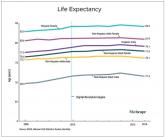Opinion
Old, Frail Patients: Study More, Intervene Less?
- Author:
- John M. Mandrola, MD
The greatest challenge for the cardiologist of today is not a lack of treatment options, but whether we should use all options in older, frailer...
News
Are Beta-Blockers Needed Post MI? No, Even After the ABYSS Trial
- Author:
- John M. Mandrola, MD
ABYSS is consistent with REDUCE-AMI, says doctor; stopping beta-blockers at 1 year did not increase death, MI, or stroke.
Opinion
Did Statin Decision-Making Just Get Harder?
- Author:
- John M. Mandrola, MD
I am not disturbed by the PREVENT score. Clinicians treat individuals, not populations.
News
Pulsed Field Ablation for AF: Are US Electrophysiologists Too Easily Impressed?
- Author:
- John M. Mandrola, MD
Clinical electrophysiologist discusses concerns about efficacy, safety, and costs of PFA.
Opinion
Is Red Meat Healthy? Multiverse Analysis Has Lessons Beyond Meat
- Author:
- John M. Mandrola, MD
A specification curve analysis of a dataset provides a much broader picture; in the case of red meat, you see some significant results, but the...
Opinion
Is AFib ablation the fifth pillar in heart failure care? CASTLE-HTx
- Author:
- John M. Mandrola, MD
- Christian Sohns, MD, PhD
- And Philipp Sommer, MD
Catheter ablation was superior to medical therapy alone in terms a composite endpoint of death from any cause or left...
Opinion
The most important study from ESC: FRAIL-AF
- Author:
- John M. Mandrola, MD
This is the kind of science that medicine should celebrate. There were no soft endpoints, financial conflicts, or spin.
Opinion
Are fish oils on the hook for AFib risk?
- Author:
- John M. Mandrola, MD
Though there is plausibility and multiple reasons to infer causality of marine omega-3s in increasing AFib risk, the effect size remains unknown...
Opinion
Three surprising studies on exercise restriction and an exercise sweet spot
- Author:
- John M. Mandrola, MD
New data ‘do not support universal restriction of vigorous exercise in patients with’ hypertrophic cardiomyopathy.
News

Taking cardiac pacing from boring to super cool
- Author:
- John M. Mandrola, MD
Ablation has hogged the electrophysiology spotlight recently, but three presentations at the 2022 Heart Rhythm Society meeting put cardiac pacing...
Opinion

Why is vitamin D hype so impervious to evidence?
- Author:
- John M. Mandrola, MD
How many nonsignificant trials do we need before researchers stop studying vitamin D, doctors stop (routinely) measuring levels, and patients stop...
News

This doc still supports NP/PA-led care ... with caveats
- Author:
- John M. Mandrola, MD
We shouldn’t be worried about non-MD clinicians, said Dr. John Mandrola, but there are ways to increase confidence in NP and PA care.
